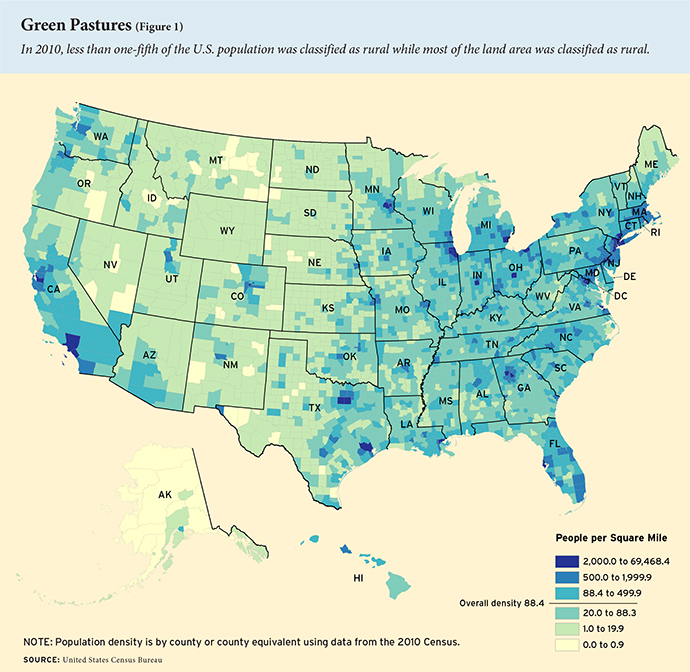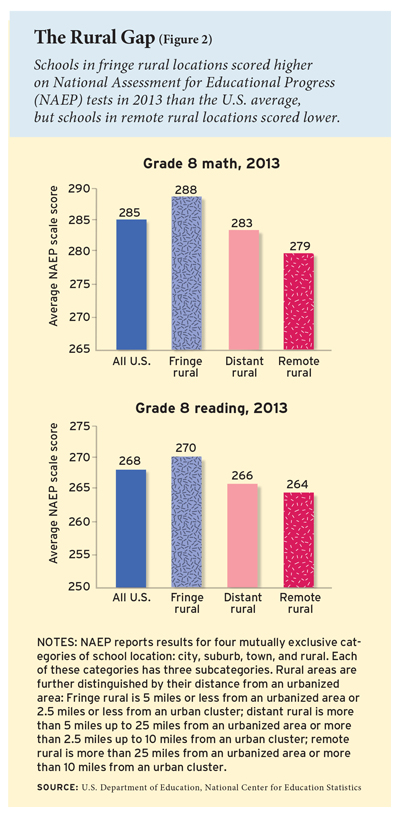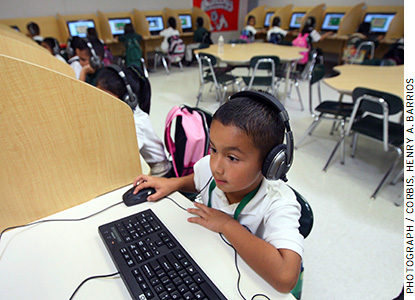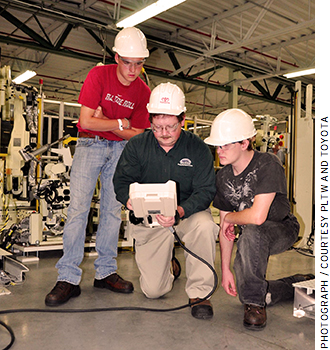 It would be impossible to consider strategies for improving rural education without examining the pressing challenges of rural life. These vary widely by community, yet important trends emerge. Texas, Kentucky, Mississippi, South Dakota, Louisiana, and Alabama include 66 of the nation’s 100 poorest counties. The historically poor regions of Appalachia and the Deep South remain so, with few catalysts to stimulate meaningful economic growth. Meanwhile, areas in the Mountain West have proven adept at leveraging high-speed Internet access and lifestyle perks to lure well-educated families and late-career professionals into permanent settlement. Yet even within the comparatively wealthy state of Colorado, the condition of rural life varies. Colorado’s Hinsdale County, population 843, and Costilla County, population 3,524, have per capita incomes of $43,293 and $16,525, respectively, despite their proximity to one another. Most of America’s landmass is to some degree rural (see Figure 1), and about one-fifth of American students live in rural regions.
It would be impossible to consider strategies for improving rural education without examining the pressing challenges of rural life. These vary widely by community, yet important trends emerge. Texas, Kentucky, Mississippi, South Dakota, Louisiana, and Alabama include 66 of the nation’s 100 poorest counties. The historically poor regions of Appalachia and the Deep South remain so, with few catalysts to stimulate meaningful economic growth. Meanwhile, areas in the Mountain West have proven adept at leveraging high-speed Internet access and lifestyle perks to lure well-educated families and late-career professionals into permanent settlement. Yet even within the comparatively wealthy state of Colorado, the condition of rural life varies. Colorado’s Hinsdale County, population 843, and Costilla County, population 3,524, have per capita incomes of $43,293 and $16,525, respectively, despite their proximity to one another. Most of America’s landmass is to some degree rural (see Figure 1), and about one-fifth of American students live in rural regions.
Overall, one in four rural children live in poverty, and of the 50 U.S. counties with the highest child-poverty rates, 48 are rural. Drug usage abounds. In the mid-2000s, rural 8th graders were 59 percent more likely than peers in large cities to use methamphetamines and 104 percent more likely to use any amphetamine, according to the National Center on Addiction and Substance Abuse. Tragically, mental health issues complicate the process of educating rural students. Individuals between 10 and 24 years of age living in rural areas are twice as likely to kill themselves as their urban peers. This may be symptomatic of the persistence of serious depression in rural America, which occurs nearly 20 percent more frequently than in urban areas. Figure 2 shows that the achievement of rural students on the National Assessment of Educational Progress (NAEP) gets worse the farther from a population center they live.

Such complex and socially entrenched ills require a proportionate educational response. Owing to a number of factors, such a response rarely occurs. Onerous policies and inadequate access to resources, among other constraints, hamper improvement of rural education. Most federal and state education policies ignore rural America’s many natural advantages and force rural school districts to operate in ways similar to those in urban centers. Various types of policies, including compliance and reporting requirements, teacher certification and evaluation schemes, funding formulas and grants, and the broader category of “innovation killers,” disadvantage rural schools in particular.
 In the post–No Child Left Behind world, reporting and compliance are significant components of a district’s work product and require substantial allocation of resources. Large urban districts may have an array of staffers and consultants to focus on compliance reporting and complete lengthy grant applications. Rural administrators often shoulder these burdens themselves, in addition to tackling numerous pressing tasks. A survey of “every report and indicator that districts are required” to produce in Colorado, for example, generated a “list [that] goes on for 59 pages. Very often, the same information is requested multiple times.”
In the post–No Child Left Behind world, reporting and compliance are significant components of a district’s work product and require substantial allocation of resources. Large urban districts may have an array of staffers and consultants to focus on compliance reporting and complete lengthy grant applications. Rural administrators often shoulder these burdens themselves, in addition to tackling numerous pressing tasks. A survey of “every report and indicator that districts are required” to produce in Colorado, for example, generated a “list [that] goes on for 59 pages. Very often, the same information is requested multiple times.”
Teacher recruitment and certification in rural communities is a struggle for school and district leaders, as well. Certification requirements, while burdensome, do little to suppress supply in urban and suburban regions: in 2013, the tony Philadelphia suburb of Cherry Hill, New Jersey, for example, fielded well over 400 applications per teaching spot. Rural districts often struggle to find even one qualified teacher per subject. Often, the most qualified community members are barred from educating students by certification rules. A seasoned musician or painter in the community may be kept from teaching art or music by licensure requirements, even if no “highly qualified” teacher can be found and classrooms lie fallow. A study in Colorado found that when new teachers are found, they can be tied up in the licensure process for up to a year, the result of outdated rules and processes. This is to say nothing of the challenge of assessing and nurturing teachers, a task greatly complicated by the Rube Goldberg evaluation requirements put into place in many states following Race to the Top. Absent access to additional supports for teachers or an enhanced talent pool, these well-meaning policies create yet another time-consuming reporting requirement that fails to support developing teachers or increase the availability of new ones.
Federal grants targeted solely at rural schools offer paltry compensation: the two main federal rural-education grants provide about $92 and $29 per pupil per year. Much of this funding is too categorical to allow for creativity in its use, locking rural administrators into spending that doesn’t necessarily yield positive results. Competitive grants can be entirely out of reach. A federal i3 (Investing in Innovation Fund) grant application, for example, is estimated to take 120 hours at a minimum (the equivalent of 15 full workdays) and is often developed in consultation with paid advisors, which few rural districts can afford. Put simply, funding formulas and education grants are not structured to support innovation and improvement in rural areas, and thereby create incentives for talent and new ideas to flow into more-populated areas.
The list of regulations that burden rural education improvement goes on and on. Seat time rules for blended learning. Prohibitions on charter schools. Inept vocational learning requirements. These and many other state and federal policies suppress the capacity of inventive rural educators to meet the needs of their students or to leverage their community’s advantages.
Local Innovation Is Imperative
If the policy environment can be improved, ambitious educators will develop appropriate solutions. Already, teachers and education entrepreneurs have demonstrated a few proof points for rural education reform: online adaptive learning delivered directly to schools and students; the development of fresh, locally relevant, and autonomous school models; and efforts to improve the quality of instruction, school management, and regulations.
The spread of online and blended learning holds particular promise in rural schools. While far from a panacea, online learning provides access to courses and resources otherwise far out of reach for students. Instructional expertise in short supply locally can be wired in from communities near and far. Students grouped with peers of varying ages and levels can advance according to their own mastery of the material. Teachers can be alerted by software when students struggle and can intervene accordingly. All of these advantages are especially helpful in regions without the requisite populations for varied course offerings or specialized instruction.
Rural communities are seeing the promise in distance learning. Iowa, for example, is working to expand its 1:1 laptop program, with more than one-third of districts now putting laptops into the hands of students to ensure online learning is constantly available. In Ohio, however, rural superintendents have embraced the potential of blended learning (a mix of adaptive online and traditional in-person learning) without actually moving to utilize the practice. While it’s evident that the proliferation of technology alone will not improve education, rural communities are particularly well suited for an online learning push.
A promising example of a replicable, blended learning effort executed at large scale can be found in Idaho, where Khan Academy’s largest U.S. pilot is under way (the largest non-American pilot is in Mongolia, a heavily rural country). Khan Academy in Idaho launched in May 2012, spreading out across nearly 600 miles of the state and serving 12,800 students in 570 classrooms. Examining the conditions that enabled this effort to occur, it becomes apparent that rural states can provide fertile ground for education innovation. This pilot crossed numerous district lines and required significant instructional change, yet the mostly rural teachers and administrators who participated readily adjusted. The swiftness with which this pilot was adopted and launched is also impressive. Organizations often find rural areas too sparsely populated to warrant much investment. Khan’s pilot proved that eager schools can be clustered to achieve scale. The foundation that principally funded this work, the J. A. and Kathryn Albertson Foundation, decided to make this $1.5 million pilot a classroom-specific grant rather than a schoolwide one, thus ensuring that only fully committed teachers participated. This constraint renders the scale of the pilot all the more striking. Official results are not available, but preliminary data are quite positive. Notably, Idaho ranked number one in the world for use of Khan Academy.

Other, less technology-heavy programs have proven their value in rural communities. Teach for America and KIPP, for example, both achieve impressive results in rural regions and continuously work toward new solutions, as with Teach for America’s recent Rural School Leadership Principal Fellowship. Yet national organizations often hemorrhage money propping up projects in rural areas that are devoid of major philanthropy. Most of the top education organizations have evolved to thrive in urban environments with higher levels of funding, significant philanthropy, and ready access to major talent pools. Some may be able to modify practices to serve the needs of rural America (New Teacher Center’s virtual teacher mentoring program is a noteworthy example), but it is likely that sustainable and appropriate solutions will more often be developed within, not appropriated from outside.
In this vein, a number of excellent school models have developed organically in rural communities. The highest-performing charters have sprung from the needs and desires of the local community. These include the Walton Rural Life Center in Kansas, which weaves agriculture and project-based instruction into almost every subject. The center, a former district school reorganized as a charter in 2007, now scores in the top 5 percent of Kansas schools. Similarly, California’s rural-adjacent Grimmway Academy achieves significantly better academic outcomes for the children of farm workers than local alternatives, with a model centered on an edible schoolyard and blended learning.
It’s worth noting that only a small portion of the rural population is employed in farming, so a much wider variety of models is necessary to provide relevant career preparation. The best of these models push communities to consider how a well-educated, thoroughly prepared workforce can improve and grow the local economy.
Is Meaningful Rural School Choice Impossible?
While expanding charters like Grimmway and Walton holds promise, districts remain the central providers of education in rural America. The two sectors have formed intriguing partnerships in a handful of rural states. The Arkansas Public School Resource Center brings rural school districts and charter schools together as partners in policy and school management. The center provides support, technical assistance, and training to both constituencies in four areas: legal services, financial analysis and management, technology, and teaching and learning. Full-time staff members travel the state to support charters and rural districts, all the while advocating for policies that benefit both. Rural superintendents often form a potent political block, so aligning these distinct groups provides political heft for reform. Among the 10 most rural states, only Arkansas has charter schools, thanks in part to this powerful alliance with rural districts (although Reimagine Prep will open the first Mississippi charter school, in Jackson, in the fall of 2015). Donors in Oklahoma and Idaho are seeding charter school efforts in their states.

The rarity of charter schools in the most-rural states raises the broader question about the viability of school choice in rural America. It makes little sense to create additional schools of choice, and thereby add to the supply of school seats, when the population of an area can barely sustain one academic program. While school choice does have a history in rural states—since 1869, Vermont has allowed parents to select a nearby school for their student to attend at the expense of their own town through a “tuitioning” program—few states have encouraged the direct creation of rural, publicly funded schools of choice. For financial reasons, private schools aren’t a particularly viable option at scale, either.
Rural communities have not embraced charter schools with the same gusto as their urban counterparts in part because they fear consolidation. The fragmentation of districts and declining populations has led to a wave of school consolidations in rural America. Nationally, over the past seven decades, the number of school districts has fallen from 117,000 to just over 14,000, with much of this impact felt in rural communities. There is concern, perhaps warranted, that the growth of a charter sector could force further consolidation and, ultimately, the dissolution of distinct communities. Despite the pedagogical and managerial freedoms charters can offer rural communities and educators, they are often viewed with suspicion. Balancing the growth of these autonomous educational institutions with the survival of existing, locally celebrated schools has proven challenging.
It may be wise to reconsider the purpose of charter schools in rural areas. Chartering could be a tactic to liberate schools from meaningless or detrimental state regulation. Certainly the autonomy that charter laws afford could be put to good use in rural schools, which labor under rules often designed for their urban cousins. If so, charter laws should be written or rewritten to emphasize independence. Convincing traditional rural schools to embrace and act upon this definition of chartering, however, seems unlikely in the near future. Various political and economic pressures, constraints, and incentives may combine to induce some communities to convert their traditional school to a charter, but it is likely that the political power rural legislators and politicians enjoy will cement the status quo in most rural districts and hamper actions that promote chartering.
The Impact of “College for All”
Do any of the proposals above address the most pressing problems facing rural communities: economic stagnation and “brain drain”—the outflow of the most intellectually talented residents to more-populated areas? One might assume, given the need to build stronger rural economies and retain local talent, that high-quality career education options would abound. This is hardly the case. Nationally, the average number of high school credits earned in career and technical education dropped notably between 1990 and 2009, while those earned in almost every other major subject area increased. Anecdotal evidence indicates that this decline is felt no less in rural regions.
The prevailing winds of education reform do not blow in the direction of career and technical education, once called vocational education. There exists an orthodoxy among education leaders, especially those involved in the no-excuses movement, that a four-year college degree is the ultimate goal for all children, regardless of background, circumstance, or geography. As such, the lion’s share of public and private resources goes into programs that advance that mission. This commitment rightly serves to equalize expectations between more- and less-privileged students and has reaped untold good by encouraging underserved students to achieve academic excellence. It also ensures that students are not “tracked” out of more rigorous courses. One might argue, though, that a college-for-all goal is suited to places like Chicago or Tampa or Phoenix, where scores of students can earn a bachelor’s degree, obtain high-paying jobs, and continue to live in and better their communities. But what of rural students, most of whom must look outside of their communities to find the sorts of jobs that college graduates are drawn to? Can a college-for-all approach enable rural communities to retain their best and brightest? Or do the interests of rural communities and those of their most talented, ambitious students inevitably conflict?
Until rural communities can create sufficient economic opportunity for college-educated citizens, or for those who for lack of viable local career opportunities leave to seek a college education, the brain drain will continue. The number of rural inhabitants with college degrees has grown significantly over time. Some 21 percent of 25- to 34-year-olds in rural communities hold a bachelor’s degree or higher, compared with 13 percent of those 65 and older. Still, college graduates make up a huge portion of individuals who leave their rural communities, by some estimates more than 40 percent. Depopulation of counties thus correlates very strongly with brain drain. Of the U.S. counties that lost population between 1970 and 2000, 95 percent were nonmetropolitan and 96 percent experienced brain drain.

An education system custom-made for rural communities would ensure that those who wish to stay in their community, and those who might return after venturing out, have access to relevant career education while they are in high school. Students should also be exposed to the best of rural entrepreneurialism and encouraged to create new ventures in their communities. The current education system, grafted haphazardly onto rural communities, is anything but fitted to local economic need.
Until schools and the federal and state policies that govern them support robust career and technical options, educational solutions to economic sclerosis will have to be cobbled together by educators, employers, and donors. Toyota, for example, has partnered with the STEM curriculum and teacher training program Project Lead the Way (PLTW) to develop a pipeline into their Advanced Manufacturing Technician program, which promises high-paying, technical jobs at Toyota’s plants in Kentucky, West Virginia, Texas, Mississippi, and Alabama, as well as at Bodine Aluminum facilities in Tennessee and Missouri. Students who complete PLTW and graduate high school in good standing spend two years earning an associate’s degree and receiving paid training from the carmaker, after which they are hired into full-time manufacturing positions at Toyota or elsewhere. While promising economic growth in rural states, this model doesn’t directly address the needs of rural high school students who aren’t within driving distance of, or willing to relocate for, good jobs in their state. This arrangement does demonstrate, however, that industry can be a valuable job-training partner for rural communities.
Schools have sprung up in rural and rural-adjacent areas with the goal of ensuring students graduate ready for college or career. In some cases, industry is leading the charge, similar to such urban efforts as IBM’s presidentially lauded P-Tech schools in New York City. In Delano, located in California’s fertile Central Valley, the agriculture giant Paramount built Agriculture Career Academy within a larger charter school. Though set on ensuring all students graduate academically prepared for college (like P-Tech, Paramount’s project is an early college high school and provides numerous no-cost college courses to enrolled students), each student also completes an apprenticeship at one of Paramount’s divisions. Within a company as large and diverse as Paramount, apprenticeship opportunities can range from legal matters to product distribution. Students can enroll in a four-year college or obtain gainful employment without a college degree if they choose to enter the workplace or a technical academy after high school.

When rural students head to far-off colleges, private and public incentives can help to bring them back and ensure their newfound skills are put to work in communities. The Greenville, Tennessee–based Niswonger Foundation, for example, offers the most talented college-bound students full scholarships to postsecondary schools of their choosing in exchange for commitment to return to and work in their often-rural eastern Tennessee communities for the same number of years they receive the scholarship. Financial aid is coupled with extensive leadership training. The Niswonger Foundation calls this effort “Learn, Earn, and Return.” Farther north, Maine Medical Center created the Maine Track MD Program to provide up to 20 Mainers each year, as well as those with strong ties to the state or an interest in rural medicine, an annual scholarship of $25,000 to pursue a medical degree at Tufts University’s School of Medicine. In exchange, students spend their third and fourth years working in one of more than three dozen medical centers scattered around the largely rural state of Maine. While students are not required to return to the state after graduation, the program was in large part created to stanch the state’s brain drain.
A Vast Expanse of Opportunity
Large swatches of rural America are struggling to educate children effectively, develop strong economic engines, and preserve communities. An education system that is lackluster in urban America is perhaps even more so in rural areas. It fails both to educate students for college and to prepare them for post–high school careers that allow for individual flourishing without draining out a community’s highest achievers. Under the current education system, it is not surprising that so many ambitious, talented individuals leave their hometowns in order to seek more engaging and remunerative job opportunities. This need not continue to be the case. Political, philanthropic, and education leaders should focus on creating the policy conditions, supporting the entrepreneurs, and more fully integrating the industry opportunities that can best address rural education improvement.
Changes to public funding schemes, policies, and economic incentives could encourage more initiatives that match educational opportunity to rural economic vitality. In order to improve rural educational quality and outcomes, the rules that hamstring educators must be lifted or amended. In areas that can support charter schools, or where districts would benefit from charter conversion, many more are needed.
Emphasis should be placed on finding, nurturing, and supporting rural entrepreneurs who wish to bring new non- and for-profit ventures to their communities. Similarly, systematic efforts to cultivate and develop quality ideas and organizations focused on elementary, secondary, and possibly even postsecondary education, perhaps modeled on the Charter School Growth Fund or NewSchools Venture Fund, must be created. An influx of capital from a prestigious venture fund, coupled with the buzz, magnetic draw, and talented mentorship this offers, could usher in a new wave of leaders from outside and within who focus on rural education issues. Given the huge variation in need between rural locations, countless strategies and campaigns are necessary.
Dan Fishman worked as a high school teacher in rural New Mexico. He is the former director of K–12 programs at The Philanthropy Roundtable and a current MBA candidate at the Berkeley Haas School of Business.
This article appeared in the Summer 2015 issue of Education Next. Suggested citation format:
Fishman, D. (2015). School Reform for Rural America: Innovate with charters, expand career and technical education. Education Next, 15(3), 8-15.


